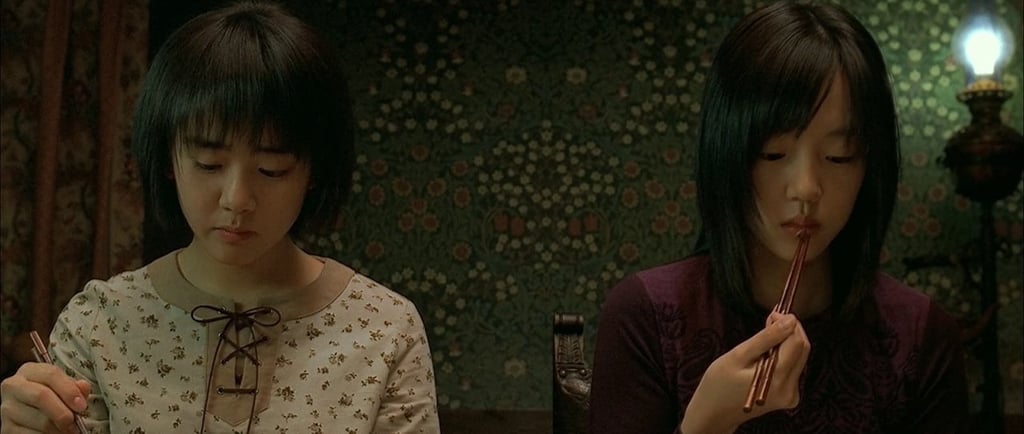Haunting Sadness: A Look at Grief in A Tale of Two Sisters (2003)
Korean horror meets psychological thriller in "A Tale of Two Sisters." Explore a family's tragedy through the lens of grief, delusion, and the haunting power of unresolved trauma
3/1/20253 min read


The Korean psychological horror film, A Tale of Two Sisters, discusses the family's tragedy and the human's besettings with sadness. The theme of the family's secret effectively demonstrates through the cinematic choice, which demises emotional and psychological sadness for So-Mi, a teenage girl with incredible remorse for her failure to save So-Yeon due to her hatred for her stepmother.
Since So-Yeon is everything to So-mi, So-mi subconsciously creates the scenario that the stepmother impounds So-Yeon inside the wardrobe. The alternate cutting between So-Mi and the stepmother accentuates the stepmother and daughter's conflict by representing the stepmother's existence is a threat to So-Mi's family and personifies her as a villain in the story, indirectly referring to So-Yeon's wound as the stepmother's fault. Moreover, because the stepmother is a villain, applying a tracking shot (in and out) when the stepmother is outside So-Yeon's bedroom allows the audience to observe the stepmother's mercilessness through her exhausted facial expression and slow walking. Through this cinematography choice, the filmmakers not only create a time gap that allows So-Mi to become a hero who rescues her sister from the wardrobe, although So-Mi's help is too late. However, this tracking shot allows So-Mi to blame the stepmother for leading to So-Yeon's death to relieve her sadness and guilt, which foreshadows her failure in reality that may also involve her and the stepmother's responsibility.
Although So-Yeon is dead, So-Mi creates So-Yeon's image inside the bloody bag and is beaten by the "stepmother." Remarkably, the use of close-up shots when So-Mi attempts to rescue So-Yeon emphasizes So-Mi's inability to protect her sister and grabs the viewer's attention and sympathy So-Mi's despair and delusion through her trepid facial expression, physical behaviors. However, the diegetic sounds such as So-Mi's screaming, breathing, and scissor rummaging function as supplemental devices that suggest So-Mi's extreme states by intensifying the close-up shot of her distorting reality. Through these choices, the filmmakers create a logical sequence of both So-Mi's subconscious and conscious mind through So-Mi's intentional behaviors, such as manically screaming and finding the scissor for rescuing So-Yeon or her breathing during the brief flashback. Specifically, So-mi's breathing sound during her flashback suggests even though So-Mi realizes her real identity, she denies it due to her desire for escaping her hope and failure to save her sister, which turns So-Mi into violence in the rest of the scene as a rebellious behavior to her subconscious mind.
Moving beyond the immediate visual and auditory cues, the film's architecture, particularly the unsettling, almost claustrophobic interior of the family home, plays a crucial role in amplifying So-Mi's psychological torment. The house, with its long, shadowy corridors and dimly lit rooms, becomes a physical manifestation of So-Mi's fractured psyche. It's a space where reality and delusion blur, where the past and present collide, and where the weight of grief becomes almost tangible.
The film's exploration of guilt and denial is particularly potent. So-Mi's inability to reconcile her role in So-Yeon's death leads her to construct an elaborate fantasy, a narrative that allows her to shift the blame onto the stepmother. This act of self-deception, while a desperate attempt to alleviate her pain, only serves to deepen her descent into madness. The film masterfully portrays the cunning nature of grief, how it can warp perception and distort reality, turning even the most loving memories into sources of unbearable anguish.
The recurring motif of the wardrobe, a seemingly harmless piece of furniture, becomes a chilling symbol of So-Mi's repressed trauma. It's a physical space where she has locked away her guilt, her pain, and her memories of So-Yeon's death. The act of confronting the wardrobe, of attempting to rescue her sister, becomes a metaphor for So-Mi's struggle to confront her own demons, to unravel the tangled web of denial and delusion that she has constructed around herself.
The film's ending, while ambiguous, offers a haunting glimpse into the enduring power of grief. It suggests that even when the truth is finally revealed, the emotional scars remain, a permanent reminder of the past and the choices that were made. A Tale of Two Sisters is not just a horror film; it's a psychological exploration of the human capacity for denial, the devastating consequences of unresolved grief, and the enduring power of familial love, even in its most twisted and distorted forms. It's a film that lingers in the mind, leaving a lingering sense of unease and a profound appreciation for the fragility of the human emotional and psyche.